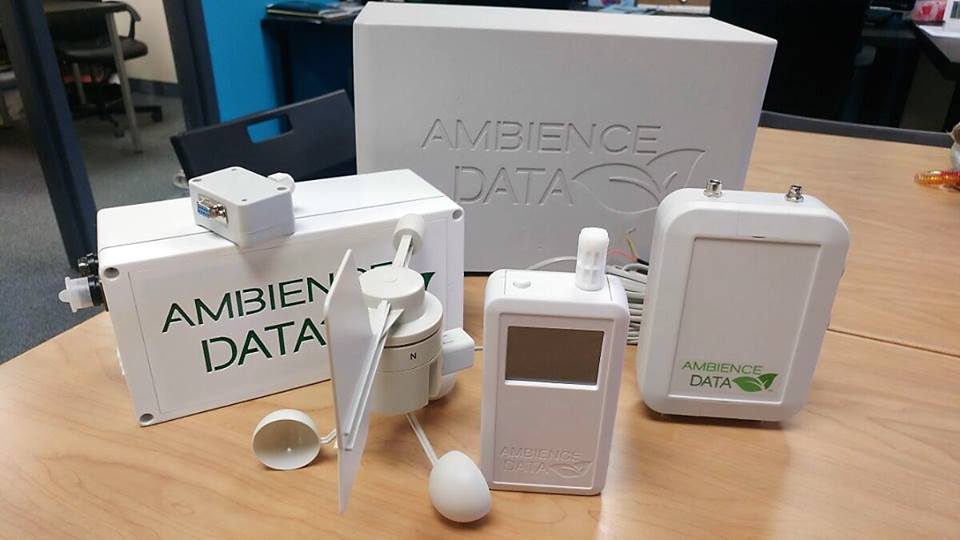As part of a regular series powered by IBM, BetaKit interviews Canadian tech leaders using innovation for the greater good.
In the environmental tech space, common missions revolve around reducing pollution, fixing destroyed habitats, or making the environment better.
Less commonly will you find a startup that wants the world to spend less money on solutions, but that’s exactly what Ambience Data hopes to do.
The company’s internet-of-things (IoT) sensors provide hyperlocal air quality data and, through machine-learning algorithms on the cloud, aid in urban development strategy. Instead of trying to fix environmental problems, co-founder and CEO Nisha Sarveswaran hopes that Ambience Data can turn the conversation to investing in prevention.
Solving big problems requires high-quality data
“I was on mat leave with my second son,” Sarveswaran said. “He had health issues, but there was no high-quality local data about air quality, so I couldn’t figure out what triggered his symptoms.”
Luckily for him, Sarveswaran is an aerospace engineer. Her Ambience Data journey officially began in 2014, when she built the original prototype for a hyperlocal air quality detection sensor.
“We don’t yet understand how air quality affects long-term health, and aggregate data is not helpful when you consider how different areas have different densities and pollutants,” she said.
“But everyday actions like recycling help to reduce waste. Knowing what we breathe is the first step to controlling our health.”
“Everyone says environmental care is the right thing to do, but no one wants to admit they have a problem in their neighbourhood or ward.”
– Nisha Sarveswaran
Ambience Data’s sensors are placed on connected hardware, which track pollution in real time wherever they are placed. The alerts then forward to algorithmic systems that, powered by IBM Cloud and machine learning, offer dashboards of health data and produce strategic recommendations for urban planners.
Sarveswaran said IoT and machine learning technologies empower people to get down to a super local level. It’s not only a cost effective technology compared to satellites, it can be deployed in rural and urban environments equally.
“It’s nice to know mass scale from satellite data, but impactful data comes from local scale,” she said. “A mom needs to know what the information means to her child. A city planner needs to know which block gives off the most pollutants.”
“You have to design for each specific neighbourhood, which means you cannot apply a blanket solution to both downtown Toronto and rural Ontario,” Sarveswaran continued. “Our data hopes to correlate with pollution data to show that it is less expensive to invest in preventative measures now, rather than pay the costs of environmental emergencies or health costs associated with pollution.”
The business (and bureaucracy) of energy
Ambience Data’s platform focuses on forecasting and prediction analysis. The company then implements its tracking both before and after major urban strategies come to fruition. That way, they see the progress (or lack thereof) and use it to inform future strategies.
Sarveswaran said that working closely with government agencies, however, is more difficult when fighting through bureaucracy.
“Everyone says environmental care is the right thing to do, but no one wants to admit they have a problem in their neighbourhood or ward,” she said. “Even major cities across the world [known as high-pollution centres] don’t know if they want this kind of information.”

In order to get around this issue without altering its mission, Ambience Data moved to a B2B business model. The company now works with real estate developers to put its sensors — both internal and external — on buildings.
“Buildings want to become energy efficient or maintain their energy efficiency status,” Sarveswaran explained. “So we put indoor and outdoor sensors on their property. Not only can we offer comparative data to the landlord about the outside versus the inside of their building, we use the outdoor data to get local air quality.”
Sarveswaran admits this model is a slower pace — it would be much faster to ink a deal with an entire municipality. However, the system works because it allows them to build their business while navigating government bureaucracy.
The power of open source
Thankfully for Ambience Data, and any organization with a social-good mission, the pace of technology is faster than the pace of government.
One particular movement that Sarveswaran credits as hugely advancing social innovation is the open source movement.
“Our data could apply to earthquake patterns, carbon tax monitoring, and others.”
Open sourcing, she said, allows social innovators to put out the fractional information they collected while building their business. Other innovators do the same, and thus a lot of readily available data is online for the next brilliant mind.
“Our data, for instance, could apply to earthquake patterns, carbon tax monitoring, and others,” she said. “There are always huge applications beyond a single use case.”
This data, while valuable by itself, is not as helpful when innovators can’t connect with one another. With the advent of social media and enterprise collaboration tools, though, that problem is now nearly nonexistent.
“Changes in technology have brought collaboration costs way down,” she said. “We can focus on social impact because we won’t have massive overhead.”
Technology costs aside, Ambience Data has also benefited from collaborations with organizations that support its mission.
“IBM has given us free access to complex software, but also invites to events and multiple introductions,” Sarveswaran said. “The team has been so supportive, and they even made introductions to other IBM people when we travelled recently for a pitch.”
Sarveswaran said that a startup with champions and the right support can go further with less funding, while noting that fundraising is something on the company’s horizon. Until that time, the Ambience Data team is pushing forward.
Photo via Unsplash


